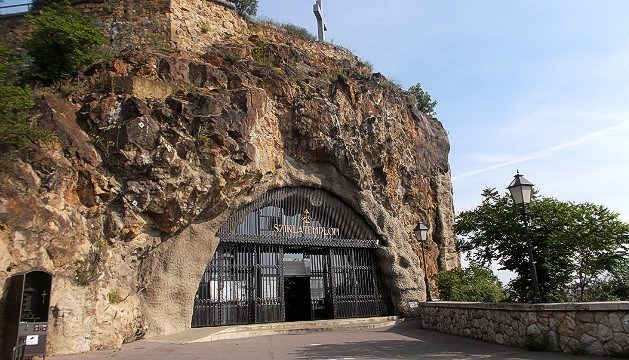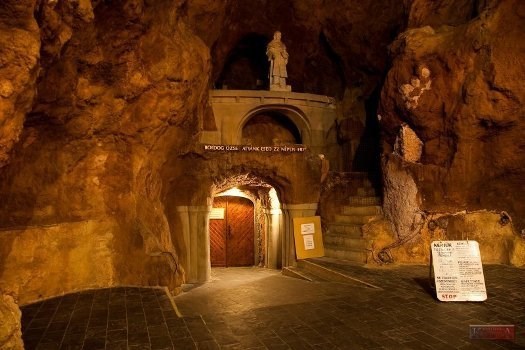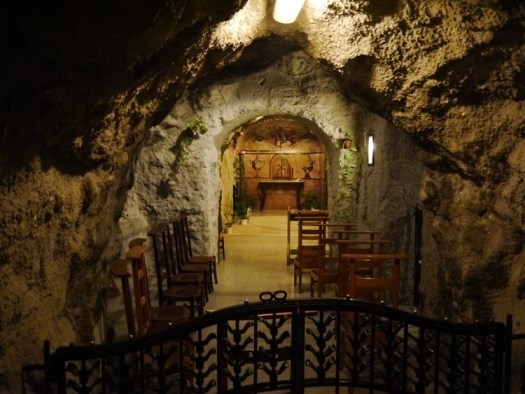
The Gellért Hill Cave Hungarian: Gellérthegyi-barlang is part of a network of caves within Gellért Hill in Budapest. The cave is also referred to as "Saint Ivan's Cave" (Szent Iván-barlang), regarding a hermit who lived there and is believed to have used the natural thermal water of a muddy lake next to the cave to heal the sick. It is likely that this same water fed the pools of the old Sáros fürdő ("Muddy Baths"), now called Gellért Baths.

In the 19th century the cave was inhabited by a poor family who built a small house of sun dried bricks in the great opening. The mouth of the cave was closed off with a planking and it was used as a peasant courtyard. This situation was recorded on a painting by Mihály Mayr (made sometime in the 1860s) and a photograph by György Klösz in 1877.
The first modern entrance for the caves was constructed in the 1920s by a group of Pauline monks who have been inspired by similar rock constructions during a pilgrimage in Lourdes, France. Kálmán Lux, professor at the Budapest University of Technology was the architect in charge. After its consecration in 1926, it served as a chapel and monastery until 1951.
In 1945, the Soviet Red Army captured Budapest. For six years, the cave continued its religious functions, but in 1951, the State Protectin Authority raided the chapel as part of increasing action against the Catholic Church. As a result of the raid, the cave was sealed, the monastery's superior, Ferenc Vezér, was condemned to death, and the remaining brothers were imprisoned for upwards of ten years.
As the Iron Curtain disintegrated, the chapel reopened on 27 August 1989 with the destruction of the thick concrete wall that had sealed the cave. By 1992, the Chapel had been restored and the Pauline Order had returned to the cave. Today, the monks continue to perform religious functions within, though the cave is also a common tourist attraction. The church is complemented by a mysterious monastery carved into the rock and decorated with striking neo-gothic turrets. The walls of the cave are formed of all-natural living rock. The church features many rooms, worthy of attention is the one in which all the ornaments have been carved in hardwood by a faithful follower of the Pauline Order. The terrace in front of the entrance is proudly guarded by the statue of Saint Stephen standing besides his horse.

To log this cache, take a picture in front of Gellert Hill Cave at the coordinates (on a voluntary basis). You also need to answer the following questions and answers to email me in the profile:
- How is cave also named?
- In which year was built the first modern entrance?
- Whats the widht for entrace of cave?
- What's the hight for entrance of cave?
- What date (XXXX X XX) is on the marble board on the right side befor enter to cave?
- Whats on the top of cave?
- Add your photo in front of the cave. (Optional)
If you log in peacefully, you do not have to wait for confirmation of correct answers. If the answers are incorrect or incomplete, I will contact you by email. If your email does not come within 3 days of the log, log without warning.

A Gellérthegyi-barlang a Gellért-hegyi barlangok hálózatának része. A barlangot Szent Iván-barlangnak is nevezik, ahol ott élt egy remete, és úgy vélik, hogy a barlang melletti sáros tó természetes termálvízét gyógyítja a betegek gyógyítására. Valószínűleg ugyanaz a víz táplálja a régi Sáros fürdő ("Muddy Baths") medencéit, amelyeket ma Gellért fürdőnek neveznek.
A 19. században a barlangot egy szegény család lakta, aki a nagy nyílásban épített egy napfényes téglaházat. A barlang száját csuklóval lezárták, és paraszt udvarként használták. Ezt a helyzetet Mayr Mihály 1860-ban készült festménye és 1877-ben Klösz György képe fényképezte.
A barlangok első modern bejáratát az 1920-as években egy olyan pálos szerzetesek alkotják, akiket hasonló kőzetszerkezetek ihlettek a lourdesi zarándoklat idején. Lux Kálmán, a Budapesti Műszaki Egyetem professzora volt a felelős építész. Az 1926-os felszentelés után 1951-ig kápolna és kolostor volt.
1945-ben a szovjet vörös hadsereg elfoglalta Budapestet. Hat évig a barlang folytatta vallási funkcióit, de 1951-ben az Állami Védelmi Hatóság a katolikus egyház ellen folytatott növekvő fellépés részévé tette a kápolnát. A raid következtében a barlangot lezárták, a kolostor felettese, Vezér Ferenc halálra ítélték, és a fennmaradó testvéreket tíz év felett börtönözték be.
Amikor a vasfüggöny lebomlott, a kápolna 1989. augusztus 27-én újra megnyílt a vastag betonfal megsemmisítésével, amely lezárta a barlangot. 1992-ig a kápolnát helyreállították és a pálosrend visszatért a barlangba. Ma a szerzetesek továbbra is vallási funkciókat töltenek be, bár a barlang közös turisztikai attrakció is. A templomot egy sziklára vésett rejtélyes kolostor egészíti ki, melyet feltűnő neogótikus tornyokkal díszítettek. A barlang falai természetes eredetű élő kőből készülnek. Az egyház számos szobával rendelkezik, amely figyelemre méltó az, amelyben az összes díszet keményfából faragták a pálosrend hű követője. A bejárat előtt álló teraszt büszkén őrzi Szent István szobra, aki a lován kívül áll.

A gyorsítótár rögzítéséhez készítsen egy képet a Gellert Hill Cave előtt a koordinátákon (önkéntes alapon). A következő kérdésekre és válaszokra is válaszolnia kell, hogy e-mailt küldjön nekem a profilban:
- Mi a barlang egyéb elnevezése?
- Melyik évben épült az első modern bejárat?
- Mekkora a barlang bejáratának a szélessége?
- Mekkora a barlang bejáratának a magassága?
- Milyen dátum (XXXX X XX) van a márvány táblán a jobb oldalon, mielőtt belépnek a barlangba?
- Mi van a barlang tetején?
- Adja hozzá fotóját a barlang előtt. (választható)
Ha békésen jelentkezik be, nem kell várnia a helyes válaszok megerősítésére. Ha a válaszok helytelenek vagy hiányosak, e-mailben értesítem a kapcsolatot. Ha az Ön e-mailje nem érkezik be a naplótól számított 3 napon belül, jelentkezzen be figyelmeztetés nélkül.
